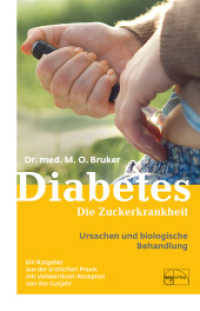Full Description
This Handbook is the key reference for contemporary historical and political approaches to gender in Central-Eastern Europe and Eurasia. Leading scholars examine the region's highly diverse politics, histories, cultures, ethnicities, and religions, and how these structures intersect with gender alongside class, sexuality, coloniality, and racism. Comprising 51 chapters, the Handbook is divided into six thematic parts:
Part I Conceptual debates and methodological differences
Part II Feminist and women's movements cooperating and colliding
Part III Constructions of gender in different ideologies
Part IV Lived experiences of individuals in different regimes
Part V The ambiguous postcommunist transitions
Part VI Postcommunist policy issues
With a focus on defining debates, the collection considers how the shared experiences, especially communism, affect political forces' organization of gender through a broad variety of topics including feminisms, ideology, violence, independence, regime transition, and public policy.
It is a foundational collection that will become invaluable to scholars and students across a range of disciplines including Women's, Gender, and Sexuality Studies and Central-Eastern European and Eurasian Studies.
Contents
Part 1: Conceptual Debates and Methodological Differences ; Introduction; The Development of the Field; Chapter 1: Between Regional and Transnational Contexts; Chapter 2: Fluidity or Clean Breaks?; Chapter 3: Neoliberal Intervention: Analyzing the Drakulić-Funk-Ghodsee Debates; Methodologies; Chapter 4: Legacies of the Cold War and the Future of Gender in Feminist Histories of Socialism ; Chapter 5: The Case and Comparative Methods; Chapter 6: Quantitative and Experimental Methods; Epistemologies; Chapter 7: Postcoloniality in Central-Eastern Europe and Eurasia; Chapter 8: Post-Soviet Masculinities: Sex, Power, and the Vanishing Subject; ; Part 2 Feminist and Women's Movements Cooperating and Colliding; Introduction; Women's Organizing under Empires; Chapter 9: Challenging Tradition and Crossing Borders: Women's Activism and Literary Modernism in the Austro-Hungarian Monarchy; ; Chapter 10: The First All-Russian Women's Congress: "The Women's Parliament" ; ; Socialist (Feminist) Interpretations; Chapter 11: The Russian Revolution and Women's Liberation: Rethinking the Legacy of the Socialist Emancipation Project ; ; Dissident Women and Feminisms ; Chapter 12: Czechoslovak Feminisms during the Interwar Period; Chapter 13: Women in Poland's Solidarity; ; ; Postcommunist NGO Feminisms and Beyond; Chapter 14: From Soviet Feminism to the European Union: Transnational Women's Movements between East and West; ; Chapter 15: Transnational Feminism and Women's NGOs: The Case of the Network of East-West Women; ; Chapter 16: Contentions of Funding Gender Equality in Central-Eastern Europe; ; ; Chapter 17: Pussy Riot and FEMEN's Global Trajectories in Law, Society, and Culture ; ; ; Part 3 Constructions of Gender in Different Ideologies ; ; Introduction; Mara Lazda, Janet Elise Johnson, and Katalin Fábián ; Nationalism; Chapter 18: Nationalism and Sexuality in Central-Eastern Europe; ; Chapter 19: Gender, Militarism, and the Modern Nation in Soviet and Russian cultures; Fascism ; ; Chapter 20: Far-Right Expectations of Women in Central-Eastern Europe; ; ; Socialisms and Communisms; ; Chapter 21: Paradoxes of Gender in Soviet Communist Party Women's Sections (the Zhenotdel), 1918-1930; Chapter 22: Women's Education, Entry to Paid Work, and Forced Unveiling in Soviet Central Asia; Chapter 23: "Gypsies"/Roma and the Politics of Reproduction in Post-Stalinist Central-Eastern Europe ; ; Chapter 24: Legalizing Queerness in Central-Eastern Europe; ; ; Democracy; ; Chapter 25: Gender and the Democratic Paradox in Latvia; ; ; Chapter 26: Anti-Gender Mobilization and Right-Wing Populism; ; Part 4 Lived Experience of the Individual in Different Regimes; Introduction; Empires and Monarchies; ; Chapter 27: Late Imperial Russia and Its Gendered Order in the Countryside; Chapter 28: Gendered Moral Panics in the Late Habsburg Monarchy: Prostitution, Sex Trafficking, and Venereal Disease; Nancy Wingfield ; ; Independence; ; Chapter 29: The Promise of Gender Equality in Interwar Central-Eastern Europe; ; ; Nazism, Stalinism, and War; ; Chapter 30: Sexuality in the Holocaust; ; Chapter 31: Deportation and Gulag as Gendered Processes; ; Socialisms and Communisms; ; Chapter 32: Yugoslav Gender Experiments and Soviet Influences; ; ; Chapter 33: Struggles to Reconcile Women's Wage Labor and Kitchen Labor in the German Democratic Republic; ; ; Part 5 The Ambiguous Postcommunist Transitions ; Introduction; Democratic and Economic Changes; Chapter 34: Gender and the Ambiguities of Economic Transition in Romania; Chapter 35: Democratization, Authoritarianism, and Gender in Russia; Europeanization; Chapter 36: Europeanization and the Challenge of Gender Equality; Chapter 37: The Europeanization and Politicization of LGBT Rights in Serbia; Migrations; Chapter 38: Russian-Speaking LGBTQ Communities in the West; Chapter 39: Postsocialist Migration and Intimacy; Armed Conflict/Resolution; Chapter 40: The International Criminal Tribunal for former Yugoslavia and the Development of Legal Frameworks on Violence against Women in Conflict; Chapter 41: Gender, Conflict, and Social Change in Armenia and Azerbaijan; Part 6 Postcommunist Policy Issues ; ; Introduction; ; Political Leadership; ; Chapter 42: Women's Representation in Politics; ; ; Gender-based Violence; ; Chapter 43: Hybrid Regimes and Gender Violence Prevention Campaigns in Ukraine; ; Chapter 44: Bride Kidnapping and Polygynous Marriages: Gendered Debates in Central Asia; ; ; Chapter 45: Trafficked Women and Men to and from Russia; ; ; Reproductive Rights; Chapter 46: Assisted Reproduction: Poland in a Comparative Perspective; Chapter 47: Abortion and Reproductive Health in Eurasia: Continuity and Change; Social Policy and Health; Chapter 48: Single Mothers, Family Change, and Normalized Gender Crisis in Russia; Chapter 49 Social Welfare and Family Policies in Central-Eastern European Countries; Chapter 50: Women's Representation in Sports; ; ; Chapter 51: Gender, Sexuality, and Disability in Postsocialist Central-Eastern Europe; ; ; ; ;







